If there ever was the need to cater to a very specific niche of the gaming audience wanting to see cartoon animals piloting disproportionate steampunk-themed mechas with grabby limbs that grab things in a grabby/throwy way, Namco Bandai’s “Tail Concerto” (1998) had it all covered. Naturally, with a title like that one would be inclined to assume it’s a game about an unstable cat lady with delusions of grandeur trying to conduct an impromptu feline orchestra in an effort to recreate Toby Fox’s “Megalovania” with the sound of cat tails smacking onto each other – or maybe that’s just me. Instead, the world depicted in the game (and in the eventual sequel) is more akin to an episode of “Tailspin” viewed under the influence of heavy Japanese-imported drugs. Which is to say, it’s an inherently interesting and creative idea that gets progressively more baffling the longer you think about it: it’s literally about an anthropomorphic dog-like creature awkwardly meandering about in a silly looking robot, fighting and defeating enemies by way of pick up and launch based mechanics.

Keeping up with the motif of bewildering videogame titles, “Solatorobo: Red the Hunter” was the 2010’s sequel/spin-off of the original “Megalotailovania Feline Orchestra in Concerto” for the Playstation One. Released a good twelve years after the first game as a Nintendo DS exclusive, “Solatorobo: Knell of Ar Ciel” tells a completely new story, with different characters, that only marginally connects with the previous iteration. This time, we fill the potentially flea-ridden shoes of Generic Deviantart Fursona #387, as he travels around a Steampunk-themed skyscape of floating citadels aboard his trusty battle mecha. His actual name is Red and he’s here to Kick Some Tail (actual dialogue line), chew bone shaped treats and hopefully get a mercenary job that pays. He also has a younger sister by the totally real name of Chocolat Gelato, because why not?
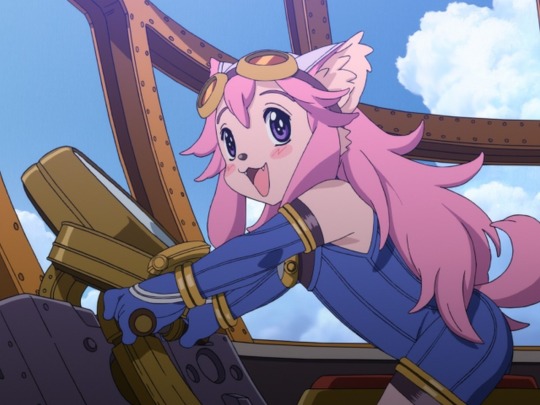
During the process of failing a secret document retrieval mission inside a very unfortunately-named flying ship, the Hindenburg, he stumbles upon Ehl, an androgynous catgirl that he HILARIOUSLY mistakes for a boy only to HILARIOUSLY discover she’s indeed female in the most HILARIOUS way possible: through a combination of happenstance, misunderstanding and a hot shower, which is apparently HILARIOUS! My patience towards the worst and most obstinate tropes from Japanese media wears thinner and thinner as the years go by.
Our hairy protagonist gets ahold of a mysterious medallion of Great Importance that quite mysteriously activates his obligatory latent powers once in his paws. Naturally, before you could cry Kyubei from the top of your lungs, Ehl proposes him to make a contract with her in exchange for an untold amount of riches, the kind of riches that almost certainly does not actually exist. In the typical conventions of this narrative style, Furball McKenzie has to find the three McGuffin Stones of World Dooming Prophecy before the customary group of incompetent evil bad guys gets in on the action. There also appears to be some sort of rejected “Kingdom Hearts” secret boss hanging in the area but I’m pretty sure that has nothing to do with anything, especially not that suspicious plot-related medallion in Red’s pockets…

On a side note, judging by various arbitrarily-recorded audio files you could hear whenever engaged in NPC dialogue, everyone in the world seems to either be speaking French or a reasonable French facsimile performed by painfully obvious non-French voice actors. That is, except for the occasional Japanese word getting thrown out there whenever Red’s little sister had to say something that I may or may not have intentionally ignored. Now, let us talk about gameplay.
“Solatorobo: Skies of Arcadia” is technically an Action Role-Playing Game in the sense that it has extremely basic experience points and levelling up mechanics, hence barely qualifying as one. Given the hardware limitations of the handheld system, there is no sandbox-style overworld exploration to be had: Red can travel from a fixed location to the next with his ship and walk around the cities and dungeons aboard his personal robot - although, he can descend from it in order to open treasure chests and retrieve semi-hidden-but-not-really collectibles.
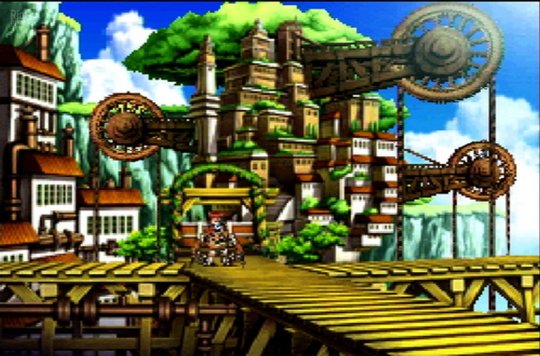
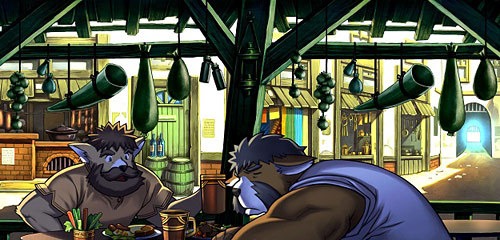
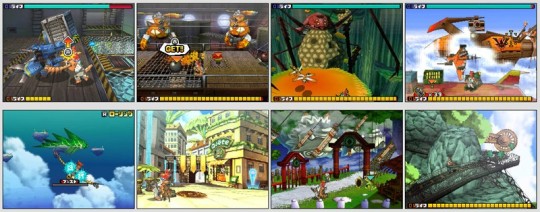
As mentioned before, the core gameplay element revolves on the mecha’s ability to grab objects or enemies and violently throw them in the general direction of their ultimate demise, which is a concept that I somewhat enjoyed on account of it mildly reminding me of “Klonoa” - another relatively obscure series that I personally adore.
The storytelling has a linear pace but you are free to slightly deviate from said path by partaking in side-quests available from Quest Brokers in any of the places you visit. Their successful completion will reward you with money, mission ranks to access even more quests and experience points. Assignments can go from pirate-thwarting ventures to time-based shenanigans that nobody likes, to fighting in tournaments and so on. Needless to say, it becomes repetitive after a while.


Levelling up is a minor focus in the gameplay since it will only slightly increase your health bar while other physical power augmentations can be achieved by customizing Red's robo-pal with additional components available from shops and by utilizing spirit crystals to create more space to allocate said components, which is a mini-game all onto itself. Of course, the fact that the game tends to be very unchallenging won’t demand a great deal of effort from your part, or at least not in its first ten hours.
All jokes considered, there is nothing fundamentally wrong with “Solatorobo: Sins of Our Fathers” aside from a seemingly in-existent level of difficulty, bare-bones characterizations and a few wincing dialogue lines; in fact, I dare say that “Solatorobo: The Red Among Us” was and still remains one of my favourite DS titles to this day. The reason for that, however, has less to do with the game itself and more to do with the far more fascinating themes that are explored once the real plot finally gets going in the second half, more or less at the same time in which this furry/mecha hybrid anime pretender with little to no substance effectively turns into an utterly insane crossover between the Saturday morning “Sonic the Hedgehog” cartoon and a less narrow-minded version of “Tengen Toppa Gurren Lagann” - sans all the penis metaphors, that is.
After dealing with the less than stellar first round villains, actual super-powered human-like creatures commandeered by the real antagonist, Dr. Gendo Robotnik (not his actual name), decide to show up and start wrecking the proverbial dog residue out of the entire IRL furry fandom in the name of Apocalyptic Accelerationism! Also, Furball McKenzie can now turn into a human too and potentially lose his mind on the irrational need to follow a very specific order given to him by an inter-dimensional weapon of mass destruction that’s supposed to be a metaphorical representation of Hell and the Apocalypse – and happens to look like a Death Star. By the way, do not be alarmed by all these spoilers: the cover art for the game’s box, as well as the two animated opening sequences included in the game, do a fine job in spoiling all the most important twists for your begrudging enjoyment.
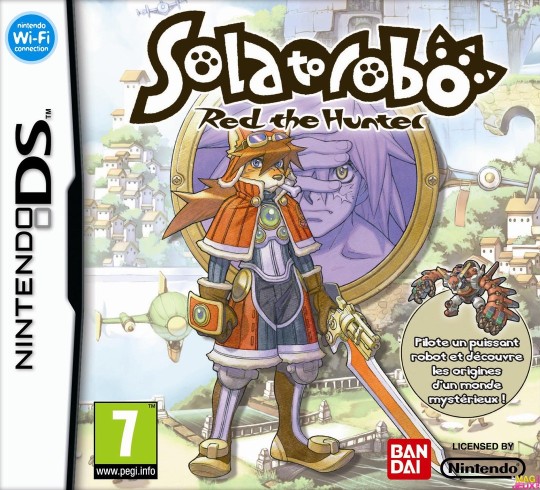
At this point in the story, “Solatorobo 3 and Knuckles” begins to demonstrate a lot of potential with its themes relating to humanity’s path towards its inevitable self-destruction. Specifically, it turns out to be a cautionary tale about the negative consequences of technological arrogance, blind progress, resource depletion and War that barely manages not to be as heavy handed as I just made it sound right now. Red and his compatriots are, by all intents and purposes, the descendants of mankind and, by banding together to fight against the threat of extinction, they are able to prove their strength and worth as a species, thus finally learning from past mistakes. In other words, this is exactly like my "Sonic the Hedgehog" fanfiction!
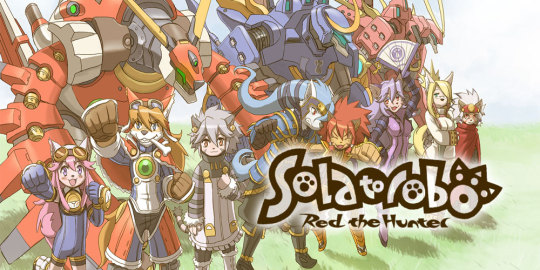
“Solatorobot Wars, Episode VII: The Fur Awakens” might have its problems but the sheer insanity of its premise and the universally understandable message it delivers make for a fairly interesting experience, at the very least. Additionally, Takayuki Isobe of .Hack curriculum is credited as the character & crowds designer and the introductory sequences were realized by acclaimed animation studio, Madhouse; which essentially means it’s a game with some pedigree. You definitely don’t need to be a furry to enjoy this… but it helps.
MADHOG HAS A PATREON
Author's note: this article was originally written, and subsequently revised on numerous occasions, in 2016. It was placed under the banner of "The Dream Traveller", a (failed) series specifically dedicated to videogame analysis and review. The unnecessary amount of snark in display here is merely a bonus.
Author's note: this article was originally written, and subsequently revised on numerous occasions, in 2016. It was placed under the banner of "The Dream Traveller", a (failed) series specifically dedicated to videogame analysis and review. The unnecessary amount of snark in display here is merely a bonus.

No comments:
Post a Comment